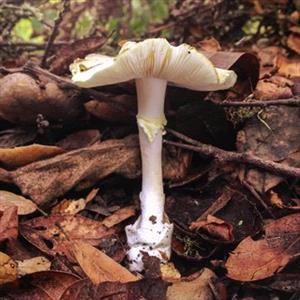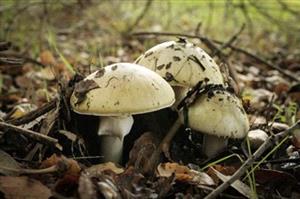
The Death Cap has gills on the underside. Photo courtesy of East Bay Regional Park District, California
You’re cruising along walking your dog Sport at the park. It’s nice to be out today since it finally stopped raining and it’s warming up nicely. He sniffs around a tree for a minute when your phone rings. Later that day, your dog is in the ER as his liver is shutting down and he is in the fiercest battle of his life.
What happened, and can Sport be saved?
What may have happened, and what is happening with more frequency, is that dogs are eating potentially fatal poisonous mushrooms found at the base of a tree. They are nicknamed the Death Cap mushroom, formally known as Amanita phalloides. This particular variety is the deadliest mushroom in the world and is responsible for about 90 percent of fatal human mushroom poisonings. As little as half of one mushroom can kill an adult human. It affects dogs in the same way, and while not all dogs who eat them will die, you can see how deadly they could be to a dog.
There’s another deadly mushroom in the U.S. called the Western Destroying Angel (Amanita ocreata) and while it too seems to be hellbent upon killing as many dogs and people as possible, it’s less common than the Death Cap. Each of these will cause hepatotoxicity, a medical word for mangling a liver. Some people who survive end up needing liver transplants, and that’s not yet possible for dogs.
Most poisonous mushroom varieties will just give you a honking headache, and maybe make you toss your cookies. Not this bad boy. It looks innocuous enough – looks a lot like some safe mushrooms — and it’s tasty. But its savagery is not to be trifled with. Since dogs like Sport can’t learn the difference between safe and deadly mushrooms, it’s up to us to keep them safe as possible.
Death Caps are sometimes seen more often during winter months and the Western Destroying Angel is usually seen around late winter and early spring, but the Death Cap is seen in the San Francisco Bay Area all year. They have a fishy smell. The worse something smells, the more attractive it is to dogs. You know how dogs approach food on the ground: it goes in the mouth as fast as possible so no one else gets it.

The Death Cap has white gills and spores, annulus or skirt present (but can be lost), with a membraneous sac at the base of the stem. Cap color varies from the classic metallic green-yellow, to tan, brown or rarely, to white. Photo courtesy of East Bay Regional Park District, California.
Usually found at the base of a live oak, in California Death Caps can now be found at the base of pine trees too. Accidentally brought in from Europe on imported trees, they can be found all over the world, but the preferred spot seems to be California with its abundance of oak trees and rain.
Does that mean Sport is going to die no matter what? It does not, although many dogs do die from ingesting these bad boys. Much depends on when treatment begins: dogs receiving care before signs start or when the dog in a coma. It also depends on dosage: how large or small the dog is, and how much was ingested. It’s harder for small children to survive this onslaught than adults. The extent of poisoning by anything always depends on the dose, so a small nibble off the edge of a Death Cap will be more harmful to a Pomeranian than a Great Dane. Of course, if the Great Dane eats several rather than a nibble, trouble is going to follow.
The symptoms aren’t seen for about 6 to 12 hours or so, and then begins severe GI distress, vomiting mushrooms, and refusing to eat or drink anything. While it's difficult to predict whether or not a dog will survive, the longer it takes from eating the bad stuff to the time signs appear, the worse the prognosis tends to be. That time frame also dictates the treatment.
Treatment generally involves decontamination by making the dog vomit whatever is in his stomach, sometimes using activated charcoal or by pumping the stomach. Supportive care is critical, which keeps the dog hydrated and gets rid of nausea and pain. In other words, it keeps the dog as comfortable as possible while the dog does all the hard work to heal. It's a bum deal that we can't offer much more (there are possible advancements on the horizon for toxicity), but there we have it.
Any dog suspected of ingesting a poisonous mushroom should be rushed to the doctor immediately; it’s an emergency if the mushroom is poisonous. If you get there and discover it’s your basic white button mushroom that you can buy at the grocery store, have a good laugh and be grateful. If the ingested mushroom was indeed toxic, the sooner you get your dog there the better off he will be, and the less money you will spend in the long run.
Unfortunately, the number of cases seen in dogs in the San Francisco Bay Area and environs has been steadily increasing, as it has elsewhere in the United States. The European mushroom is now being seen in more and more places across the United States and Canada. Amanita arocheae, the "Latin American death cap," grows in Mexico, Central America and South America and can also be fatal. Don’t forget that the vast majority of mushrooms are safe, but toxic mushrooms can be easily confused with safe mushrooms.

This mushroom is commonly called the Death Cap. Photo courtesy of East Bay Regional Park District, California
What are dog owners supposed to do?
Safety tip #1: You cannot do anything to remove the toxin in order to make the Amanitas safely edible. Boiling, baking, freezing, drying, microwaving, roasting or dropping them off a cliff into salty sea water does not affect the toxins. They stay put. You should not even touch these guys, much less consider eating them or letting your dog or cat do so.
Safety tip #2: If you see your dog eating any kind of mushroom, use a clean poop bag to get a sample of it for the veterinarian. Doing so can make all the difference. At the very least, take a photo, but bringing one in is much better. The vast majority of mushrooms are quite safe, but the few that are not are bad. Also, when it comes time to go to the veterinarian, if possible bring samples of vomit or feces.
Safety tip #3: Do not eat any wild mushroom that you are not 100 percent certain is safe. Have it checked by a mycologist or a long-time mushroom hunter. The old adage says it all: there are old mushroom hunters, there are bold mushroom hunters, but there are no old, bold mushroom hunters.